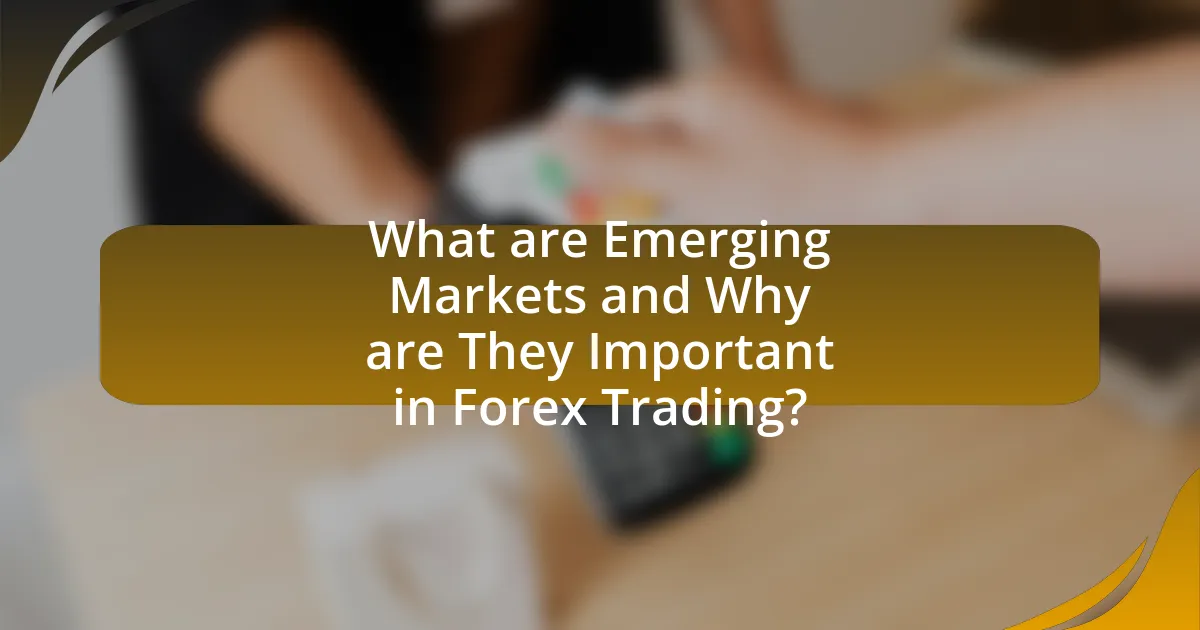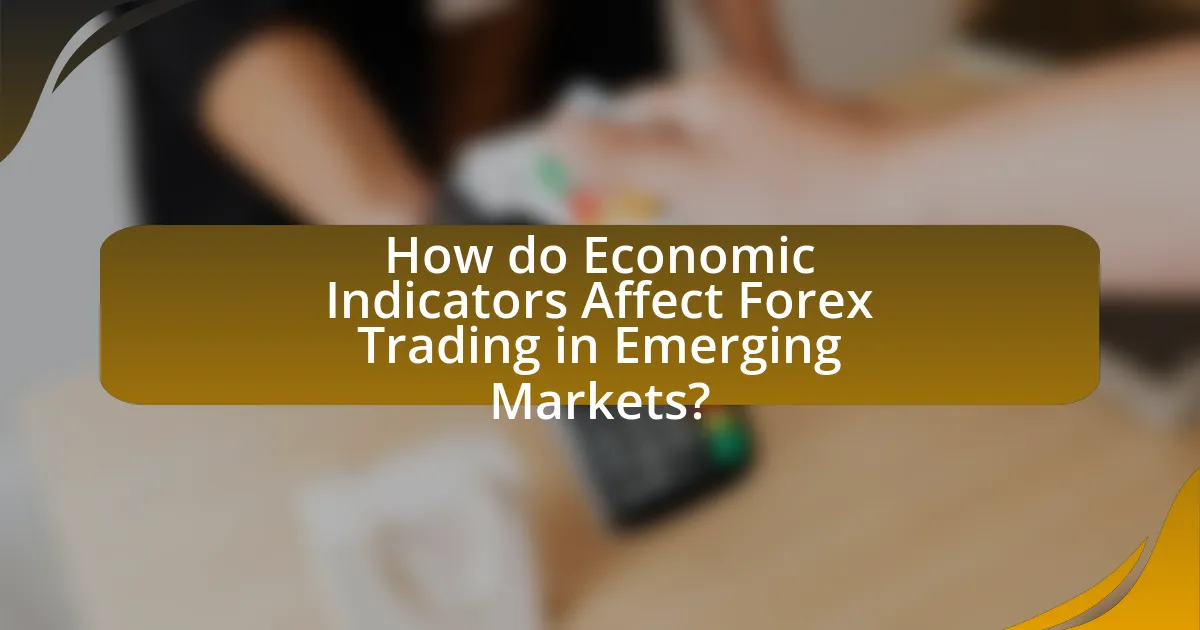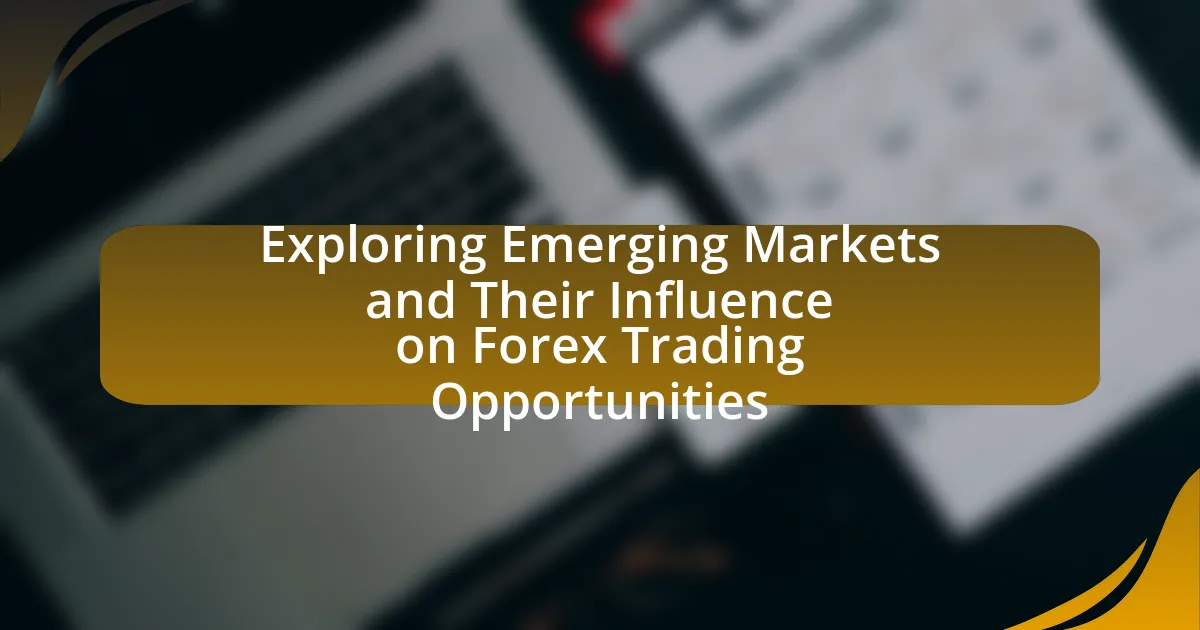Emerging markets are economies undergoing rapid growth and industrialization, characterized by increasing economic development and rising income levels. This article explores the significance of emerging markets in Forex trading, highlighting their potential for higher volatility and returns compared to developed markets. Key topics include the differences between emerging and developed markets, the impact of economic indicators and political factors on currency values, and effective trading strategies for capitalizing on opportunities in these regions. Additionally, the article addresses risk management techniques and common pitfalls to avoid when trading in emerging markets, providing valuable insights for traders seeking to navigate this dynamic landscape.

What are Emerging Markets and Why are They Important in Forex Trading?
Emerging markets are economies that are in the process of rapid growth and industrialization, characterized by increasing economic development, improving infrastructure, and rising income levels. These markets are important in Forex trading because they often present higher volatility and potential for significant returns compared to developed markets. For instance, according to the International Monetary Fund, emerging markets are projected to account for over 60% of global GDP growth by 2025, highlighting their increasing influence in the global economy. This growth attracts Forex traders seeking to capitalize on currency fluctuations driven by economic changes, political developments, and market sentiment in these regions.
How do emerging markets differ from developed markets?
Emerging markets differ from developed markets primarily in their economic stability, growth potential, and market maturity. Emerging markets, such as Brazil and India, typically exhibit higher growth rates due to industrialization and urbanization, while developed markets, like the United States and Germany, have more stable economies with slower growth rates. Additionally, emerging markets often face greater volatility and risk, including political instability and less mature financial systems, which can impact investment opportunities. According to the International Monetary Fund, emerging markets are projected to grow at a rate of 4.5% compared to 2% for advanced economies in the coming years, highlighting the significant differences in growth potential.
What characteristics define an emerging market?
Emerging markets are characterized by rapid economic growth, increasing industrialization, and improving infrastructure. These markets typically exhibit a transition from developing to developed status, often marked by rising income levels and a growing middle class. For instance, countries like India and Brazil have shown significant GDP growth rates, often exceeding 5% annually, indicating robust economic activity. Additionally, emerging markets often have less mature financial systems, which can lead to higher volatility in investment returns. This volatility is evidenced by fluctuating currency values and stock market performance, making them attractive yet risky for forex trading opportunities.
Why do investors seek opportunities in emerging markets?
Investors seek opportunities in emerging markets primarily due to the potential for higher returns compared to developed markets. Emerging markets often exhibit rapid economic growth, which can lead to increased corporate profits and investment opportunities. For instance, according to the International Monetary Fund, emerging economies are projected to grow at a rate of 4.5% annually, significantly outpacing the growth of developed economies, which are expected to grow at around 2%. This disparity in growth rates attracts investors looking for capital appreciation and diversification in their portfolios.
What role do emerging markets play in the global economy?
Emerging markets play a crucial role in the global economy by driving economic growth, contributing to global trade, and attracting foreign investment. These markets, characterized by rapid industrialization and increasing GDP, accounted for approximately 60% of global GDP growth in recent years, highlighting their significance. Additionally, emerging markets often provide new opportunities for businesses and investors, as they typically have higher growth rates compared to developed economies. For instance, countries like India and Brazil have seen substantial foreign direct investment inflows, which further integrate them into the global economic framework. This integration enhances global supply chains and fosters innovation, making emerging markets vital players in shaping the future of the global economy.
How do emerging markets contribute to global trade?
Emerging markets contribute to global trade by serving as significant sources of raw materials, manufacturing goods, and expanding consumer markets. These economies, characterized by rapid growth and industrialization, account for a substantial portion of global exports; for instance, in 2021, emerging markets represented approximately 40% of global merchandise exports. Additionally, their increasing middle-class populations drive demand for various products, further integrating them into the global supply chain. This integration enhances trade relationships and fosters economic interdependence, which is crucial for global economic stability and growth.
What impact do emerging markets have on currency values?
Emerging markets significantly influence currency values through factors such as economic growth, interest rates, and geopolitical stability. When emerging markets experience robust economic growth, their currencies often appreciate due to increased foreign investment and demand for exports. For instance, countries like Brazil and India have seen their currencies strengthen during periods of high GDP growth, reflecting investor confidence. Conversely, political instability or economic downturns in these markets can lead to currency depreciation, as seen during the 2018 Turkish currency crisis, where the lira plummeted due to economic mismanagement and geopolitical tensions. Thus, the economic conditions and political landscape of emerging markets directly impact their currency values, affecting global forex trading dynamics.

How do Economic Indicators Affect Forex Trading in Emerging Markets?
Economic indicators significantly influence Forex trading in emerging markets by providing insights into the economic health and stability of these countries. For instance, indicators such as GDP growth rates, inflation rates, and unemployment figures can affect currency valuations. When a country shows strong GDP growth, it typically attracts foreign investment, leading to an appreciation of its currency. Conversely, high inflation can erode purchasing power and lead to currency depreciation. Historical data supports this; for example, during the 2010s, Brazil’s currency, the real, fluctuated in response to changes in inflation and interest rates, impacting Forex trading strategies. Thus, traders closely monitor these indicators to make informed decisions in emerging markets.
What key economic indicators should traders monitor in emerging markets?
Traders should monitor GDP growth rates, inflation rates, interest rates, and unemployment rates as key economic indicators in emerging markets. GDP growth rates indicate the overall economic health and potential for investment returns; for instance, a consistent increase in GDP can signal a robust economy attracting foreign investment. Inflation rates reflect the purchasing power and cost of living, with high inflation potentially eroding returns; for example, countries like Argentina have experienced hyperinflation, impacting currency stability. Interest rates influence borrowing costs and investment attractiveness; lower rates can stimulate growth, while higher rates may attract foreign capital. Lastly, unemployment rates provide insights into labor market conditions and economic stability; high unemployment can indicate economic distress, affecting currency value. Monitoring these indicators helps traders make informed decisions in the volatile landscape of emerging markets.
How do GDP growth rates influence currency strength?
GDP growth rates directly influence currency strength by affecting investor confidence and capital flows. When a country’s GDP grows, it typically signals a robust economy, attracting foreign investment and increasing demand for that country’s currency. For example, during the period of strong GDP growth in the United States from 2017 to 2019, the U.S. dollar strengthened against many currencies due to heightened investor interest and capital inflows. Conversely, stagnant or declining GDP growth can lead to currency depreciation as investors seek more lucrative opportunities elsewhere. This relationship is supported by economic theories that link growth rates to currency valuation, demonstrating that higher GDP growth generally correlates with stronger currency performance.
What is the significance of inflation rates in forex trading?
Inflation rates are significant in forex trading because they directly influence currency value and investor sentiment. When a country’s inflation rate rises, its currency typically depreciates as purchasing power declines, leading traders to sell that currency. Conversely, low inflation rates can strengthen a currency, attracting foreign investment. For example, the U.S. Federal Reserve’s interest rate decisions, often influenced by inflation data, can lead to substantial fluctuations in the USD’s value against other currencies. Historical data shows that a 1% increase in inflation can lead to a corresponding decrease in currency value, highlighting the critical role inflation plays in forex market dynamics.
How do political factors impact forex trading in emerging markets?
Political factors significantly impact forex trading in emerging markets by influencing currency stability and investor confidence. For instance, political instability, such as government changes or civil unrest, can lead to rapid depreciation of a country’s currency, as seen in Venezuela, where hyperinflation and political turmoil have drastically affected the bolívar’s value. Additionally, government policies, such as trade agreements or sanctions, can alter market perceptions and trading volumes; for example, the U.S. sanctions on Iran have led to a sharp decline in the Iranian rial’s value. Thus, the political landscape directly affects forex trading dynamics in these markets through currency fluctuations and investor sentiment.
What role does political stability play in currency valuation?
Political stability significantly influences currency valuation by fostering investor confidence and reducing risk perception. When a country maintains a stable political environment, it attracts foreign investment, which increases demand for its currency. For instance, according to the International Monetary Fund, countries with stable governments often experience stronger currencies due to lower volatility and predictable economic policies. Conversely, political instability can lead to currency depreciation as investors seek safer assets, evidenced by the sharp decline in the Argentine peso during periods of political turmoil. Thus, political stability is a crucial determinant of currency strength and overall economic health.
How can government policies affect forex trading opportunities?
Government policies significantly influence forex trading opportunities by affecting currency values, market stability, and investor confidence. For instance, a government’s monetary policy, such as interest rate changes, directly impacts currency strength; when a central bank raises interest rates, it typically leads to an appreciation of the currency due to higher returns on investments denominated in that currency. Additionally, fiscal policies, including taxation and government spending, can alter economic growth prospects, influencing forex market dynamics. Historical examples include the U.S. Federal Reserve’s quantitative easing measures, which led to a depreciation of the U.S. dollar, affecting global forex trading strategies. Thus, government policies shape the forex landscape by determining currency valuations and market conditions.

What Strategies Can Traders Use to Capitalize on Emerging Market Opportunities?
Traders can capitalize on emerging market opportunities by employing strategies such as diversification, currency pair selection, and leveraging local insights. Diversification allows traders to spread risk across various assets in different emerging markets, reducing the impact of volatility in any single market. Currency pair selection involves focusing on pairs that include currencies from emerging markets, which can exhibit higher volatility and potential for profit. Leveraging local insights, such as understanding political and economic conditions, can provide traders with a competitive edge in predicting market movements. For instance, according to a report by the International Monetary Fund, emerging markets are projected to grow at a rate of 4.5% annually, highlighting the potential for significant returns for traders who strategically engage with these markets.
What are the best trading strategies for emerging markets?
The best trading strategies for emerging markets include diversification, currency hedging, and utilizing local knowledge. Diversification across various sectors and countries helps mitigate risks associated with volatility in emerging markets. Currency hedging protects against adverse currency fluctuations, which are common in these markets. Utilizing local knowledge, such as understanding cultural and economic factors, can provide insights that enhance trading decisions. These strategies are supported by data indicating that diversified portfolios in emerging markets can yield higher returns while reducing risk, as evidenced by studies from the International Monetary Fund showing that emerging market equities have outperformed developed markets over the long term.
How can traders leverage volatility in emerging markets?
Traders can leverage volatility in emerging markets by employing strategies such as options trading, currency pairs trading, and utilizing stop-loss orders. These strategies allow traders to capitalize on price fluctuations that are often more pronounced in emerging markets due to economic instability and geopolitical factors. For instance, during periods of heightened volatility, traders can use options to hedge against potential losses while still benefiting from upward price movements. Additionally, trading currency pairs that include emerging market currencies can yield significant returns, as these currencies often experience larger swings compared to developed market currencies. Historical data shows that emerging market currencies can exhibit volatility levels exceeding 10% in a single month, providing ample opportunities for traders to profit from rapid price changes.
What risk management techniques are essential for trading in these markets?
Essential risk management techniques for trading in emerging markets include diversification, position sizing, and the use of stop-loss orders. Diversification reduces exposure to any single asset or market, thereby mitigating potential losses. Position sizing involves determining the appropriate amount of capital to risk on each trade, which helps manage overall portfolio risk. Stop-loss orders automatically close a position at a predetermined price, limiting losses in volatile markets. These techniques are crucial as emerging markets often exhibit higher volatility and unpredictability compared to developed markets, making effective risk management vital for sustaining trading success.
How can traders stay informed about emerging market trends?
Traders can stay informed about emerging market trends by utilizing a combination of financial news platforms, economic reports, and social media analytics. Financial news platforms such as Bloomberg and Reuters provide real-time updates and in-depth analysis of market movements, while economic reports from institutions like the International Monetary Fund (IMF) and World Bank offer valuable insights into macroeconomic indicators. Additionally, social media platforms can be monitored for sentiment analysis and discussions among market participants, which can highlight emerging trends. According to a 2022 report by the IMF, timely access to diverse information sources significantly enhances traders’ ability to anticipate market shifts and make informed decisions.
What resources are available for tracking emerging market developments?
Resources available for tracking emerging market developments include financial news platforms, economic databases, and specialized research reports. Financial news platforms such as Bloomberg and Reuters provide real-time updates and analysis on market trends and economic indicators. Economic databases like the World Bank and International Monetary Fund offer comprehensive data on GDP growth, inflation rates, and trade balances, which are crucial for understanding emerging markets. Additionally, research reports from institutions like McKinsey & Company and the Economist Intelligence Unit provide in-depth insights and forecasts on specific regions and sectors, enhancing the ability to monitor and analyze emerging market dynamics effectively.
How can networking with other traders enhance market insights?
Networking with other traders enhances market insights by facilitating the exchange of diverse perspectives and strategies. Engaging with a variety of traders allows individuals to access real-time information about market trends, sentiment, and emerging opportunities that may not be readily available through traditional analysis. For instance, traders often share insights on geopolitical events or economic indicators that can significantly impact currency values, leading to more informed trading decisions. Additionally, collaborative discussions can reveal unique trading strategies and risk management techniques, which can improve overall trading performance. This collective knowledge can be particularly valuable in the context of emerging markets, where information may be less accessible and market dynamics can shift rapidly.
What are the common pitfalls to avoid when trading in emerging markets?
Common pitfalls to avoid when trading in emerging markets include lack of thorough research, underestimating volatility, ignoring local regulations, and failing to account for currency risk. Traders often neglect comprehensive analysis of economic indicators and political stability, which can lead to poor investment decisions. For instance, emerging markets can experience significant price swings due to political unrest or economic changes, making it crucial for traders to stay informed. Additionally, local regulations can vary widely and may impact trading strategies; thus, understanding these rules is essential. Currency risk is another critical factor, as fluctuations in exchange rates can significantly affect returns. According to a report by the International Monetary Fund, emerging markets can exhibit higher volatility, emphasizing the need for risk management strategies tailored to these environments.
How can traders identify and mitigate risks in emerging markets?
Traders can identify and mitigate risks in emerging markets by conducting thorough market analysis and employing risk management strategies. Market analysis involves assessing economic indicators, political stability, and currency volatility, which helps traders understand the potential risks associated with specific countries. For instance, the International Monetary Fund (IMF) provides data on GDP growth rates and inflation, which can signal economic health or instability.
To mitigate risks, traders can diversify their portfolios across different emerging markets and asset classes, reducing exposure to any single market’s downturn. Additionally, using financial instruments such as options and futures can provide hedging opportunities against adverse market movements. According to a study by the World Bank, diversification can significantly lower risk in volatile markets, as it spreads exposure across various economic conditions.
Implementing stop-loss orders is another effective strategy, allowing traders to limit potential losses by automatically selling assets when they reach a predetermined price. This approach is particularly useful in the unpredictable environments typical of emerging markets.
What lessons can be learned from past trading failures in these markets?
Past trading failures in emerging markets highlight the importance of risk management and the need for thorough market analysis. For instance, the 1997 Asian Financial Crisis demonstrated how lack of transparency and excessive leverage can lead to catastrophic losses. Investors should prioritize understanding local economic conditions and political stability, as evidenced by the 2001 Argentine economic crisis, where mismanagement and default on debt led to significant market turmoil. Additionally, the 2008 global financial crisis underscored the risks of interconnected markets, emphasizing the necessity for diversification and cautious investment strategies. These historical events serve as critical reminders for traders to adopt disciplined approaches and remain vigilant about external factors influencing market dynamics.
